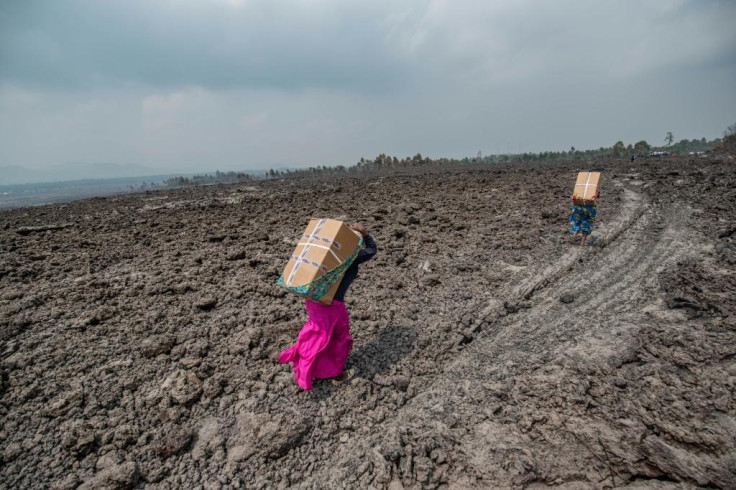Mass exodus as new eruption of DR Congo volcano feared
The UN humanitarian agency OCHA said more than 4,500 homes were destroyed, affecting some 20,000 people.
Tens of thousands of people choked the route out of Goma Thursday, fleeing the eastern DR Congo city after the local governor warned that the Mount Nyiragongo volcano might erupt again.
Miles of traffic jams blocked the main road leaving Goma to the west, as cars, vans, and trucks packed with people tried to get to Sake in the mountainous Masisi region.

Goma, located on the shore of Lake Kivu, has been on edge since Africa's most active volcano erupted on Saturday, leaving 32 people dead.
The volcano's monitors have warned of a potentially catastrophic scenario -- a "limnic eruption" that could smother the area with suffocating carbon dioxide.
Experts at the summit of the volcano were carrying out a risk assessment, said the government.

Early in the morning, General Constant Ndima, the military governor of North Kivu province, ordered the evacuation of part of the city of more than 600,000 -- among some two million in the greater urban area.
"Right now we can't rule out an eruption on land or under the lake, which could happen very soon and without warning," he said.
The authorities had arranged transport towards Sake, around 20 kilometres (12 miles) west of Goma, he added.

The city streets were jammed with people walking or running, carrying mattresses, sports bags or a few meagre possessions in plastic bags, and holding on to frightened children.

"There are lots of aftershocks. A lot of people are going to die," said one local, Chadrack Bahati. "That's why they're telling us to get out of Goma."
Around him, clusters of men tried to grab onto moving vehicles that had slowed down.
Although tens of thousands fled Goma after Nyiragongo erupted on Saturday night, many subsequently returned.
But strong aftershocks have continued to rattle the city, causing some buildings to collapse and leaving residents fearful.
The volcano spewed out two rivers of molten rock during the eruption, one of which came to halt on the edge of Goma after obliterating villages in its wake.
The UN humanitarian agency OCHA said more than 4,500 homes were destroyed, affecting some 20,000 people.
Local volcanologists have recorded hundreds of aftershocks since Nyiragongo, which sits just a dozen kilometres (eight miles) from Goma, roared back to life.
Ndima said the latest data suggested the presence of magma -- molten, or semi-molten material -- under Goma itself and perhaps even Lake Kivu.
Any interaction between magma and the lake could produce "potentially dangerous gases at the surface", he warned.

Volcanologists say a worst-case scenario would be an eruption beneath the floor of Lake Kivu.
That could force carbon dioxide dissolved in the lake's depths up to the surface, releasing invisible clouds of suffocating gas.
A "limnic eruption" of this kind in 1986 killed more than 1,700 people and thousands of heads of cattle in Lake Nyos, in Cameroon.
Government spokesman Patrick Muyaya said another disaster scenario was of magma igniting a pocket of methane gas under the lake.
And there was also the toxic risk from dust and ash disgorged into the air by the volcano, he added.
A team of experts sent early Thursday to the summit of the volcano were evaluating the various risks, he said.
The evacuation of 10 of Goma's 18 neighbourhoods is taking place along three main axes -- the highway to Sake, the Rwandan border, and the north eastern route towards Rutshuru, which lava damage shut down for 48 hours.
By the afternoon however, the governor began urging people away from Sake, which he said was saturated, and to head north instead. "There's good space, water, and hospitals," he said.
In Sake, some new arrivals were putting up makeshift shelters for the night, while others found refuge in churches and schools.
Muyaya said that the Rutshuru highway had been repaired and that the police and army were deployed in Goma to help with the evacuation.
But many of those heading out of Goma complained they had seen little evidence of such measures. They complained that within a few hours the price of petrol had trippled to over 5,000 Congolese francs ($3).
An AFP correspondent reported tens of thousands of people in vehicles of all kinds heading towards the Rwandan border.
People also massed at Goma's Lake Kivu port, hoping for a boat to Bukavu, to the south. But the authorities, probably fearing overcrowding and possible capsizing, barred lake traffic on Thursday.
Its last major eruption, in 2002, claimed around 100 lives.
The deadliest eruption on record killed more than 600 people in 1977.
Copyright AFP. All rights reserved.
This article is copyrighted by International Business Times, the business news leader





















